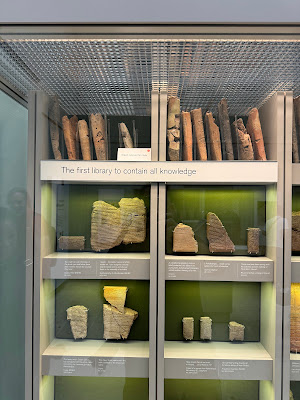If you don't know and get asked by the Bridge Keeper, it is Assur, at least it was until 879 BC, when it was moved to Nimrud, then it was moved to Dūr Šarrukīn and thence to Nineveh, which remained the capital until the Assyrian empire fell to the Babylonians/Medes in 612 BC, so any of those should suffice to let you cross.
The Mespotamian collection is rather impressive at the British Museum.
Two colossal statues of winged lions with human heads that used to stand at the entrance to the royal palace of King Ashurnasirpal II (883-859 BC) in Nimrud
The Museum in its Assyrian exhibit has a display containing the world's first known library. The Library of Ashurbanipal, King of the Neo-Assyrian Empire:
Clay tablets, with many still in their clay envelopes, as they would have been at the time. The envelope both kept the tablet secure from being read by the unauthorized, and also had a label describing what was on the tablet within. The library contains many tablets works, including an archive of royal communications including one demanding that rare tablets to be sent to the library.
Quite cool.
The Assyrians were less famous for being librarians than their fame, if not infamy, for the warfare that led them to expand and control their empire, and their extremely brutal treatment of all who resisted them.
An Assyrian carving showing an attack:
The next carving shows them removing enemy deities from a captured city while they sack it:
This carving shows an arms-bearer of Tiglath-Pileser III
An Assyrian iron helmet from the era is also on display:
The Assyrian exhibit at the British Museum is extensive and quite impressive to see. Just standing beside one of the huge lions gives you quite an appreciation for the grandeur of this long-ago empire that at its height dominated much of the Middle East.








No comments:
Post a Comment